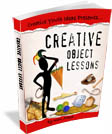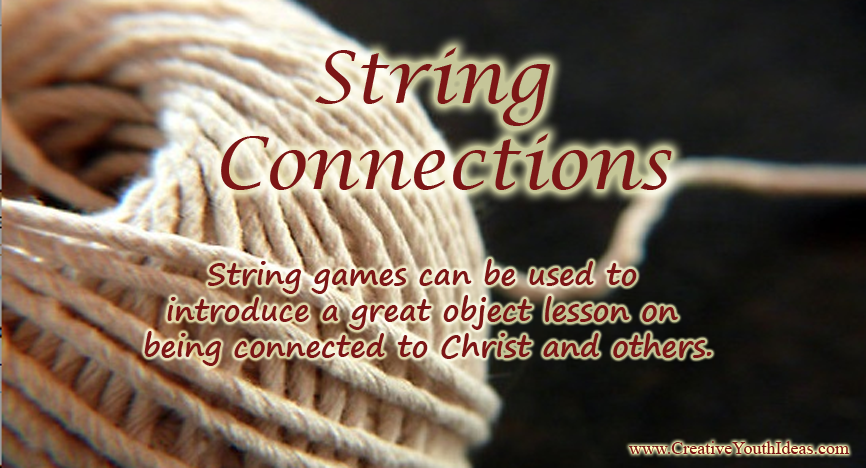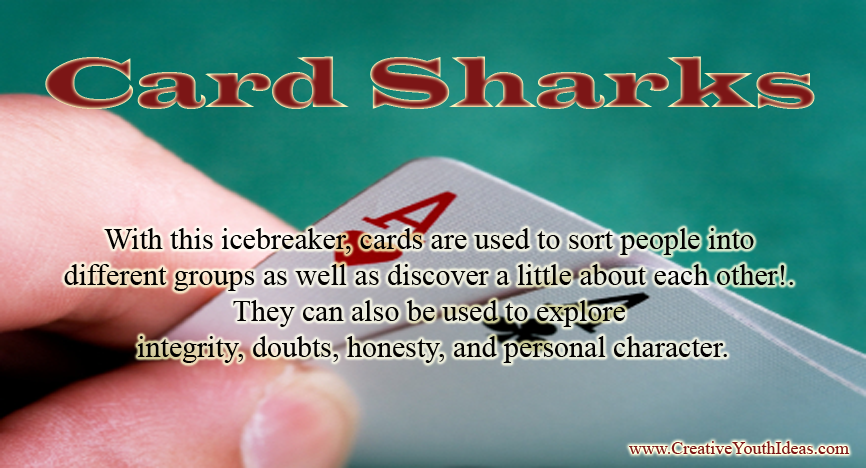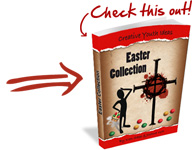Almost everyone has some string lying around the house. Most often, string is used to connect things. As such, the string games below can be used to introduce a great object lesson on being connected to Christ and others.
PLEASE SHARE STRING CONNECTIONS ON FACEBOOK – CLICK HERE
What You Need
- Lots of string
Games Using String
- All Inside – Lay a circle of string on the ground and ask a team of youth (6-15 people) to stand inside the circle. Everyone must be touching the ground inside the string circle in some way. They must stay inside the circle for the amount of time it takes them to sing the chorus of a song familiar to the youth. No one can touch the ground outside the shoestring circle. Then tie an 8 inch loop in the string and try again. Team to fit inside the smallest circle of string wins.
- Loop Groups – Create a loop of string about the size of a hula hoop. Ask the youth to stand in a circle and hold hands. Then have one pair of youth release their hands reach through the string circle and then re-connect hands. The shoestring circle must travel in a clockwise direction and return to the initial starting position without anyone letting go of hands. The youth must stay in one location while the shoestring circle moves around the circle. Fastest time wins.
- Polygon – Tie a long piece of string together at the ends to form a circle. All the youth hold onto the circle with both hands and then asked to form a specific shape without letting go. (e.g.: Perfect circle, square, equilateral triangle, Letter C, etc). Stage 1: No talking. Stage two – Can talk but eyes closed.
- String Introductions – Take a pair of scissors and cut pieces of string or yarn into various lengths. (12-30 inches in length) Then bunch them all up in one pile. Each youth pulls on one piece of string to separate it from the others then introduces him or herself as he or she slowly winds the piece of string around an index finger. Some of the strings are extremely long, so sometimes a person must keep talking for a very long time!
- String spelling – Played like charades, youth must guess a series of words or items from a list, but instead of miming them, they try to spell them out with the piece of string.
- Tennis Ball Transport – You’ll need some large washers (or a curtain ring), some string, and some tennis balls. Tie five to eight long cord pieces (4-6 feet long) to a washer (or curtain ring). Place the washer on the ground with the cords coming out from it like rays of sunshine. Place a tennis ball on top of the washer. The challenge is for the youth to pick up the washer and tennis ball by hanging onto the strings only without the tennis ball falling off. Need more of a challenge? Switch strings with another group without dropping a tennis ball.
A String Game and a Lesson
- Sit the group on the floor in a circle with everyone facing inward toward the center of the circle.
- Tell everyone your name and one characteristic about yourself.
- Holding firmly to the end of the string, toss the ball of string to someone in the circle who has not yet received the string.
- The youth receiving the string gives his/her name and one characteristic.
- Then, holding firmly onto the string, he or she tosses the ball on to another person.
- The string should be held tightly and above the ground at all times.
- Continue until everyone has received the string at least once and has told the group their name and shared one characteristic.
TAKE IT TO THE NEXT LEVEL
GENERAL DISCUSSION
- Have someone in the group pull the string – What happens?
- Have everyone pull the string tight then cut the string in the middle. What happens?
- In what ways does the string represent various relationships in the youth group?
(Sample answers: Our relationships are intertwined and connected. If a single person pulls the string it affects everyone in the group to varying degrees, depending on how closely they are connected. If one persons string is cut the relationship is broken, it affects all. We need to support each other and not let others down)
MAKE IT SPIRITUAL
John 15 speaks of the Vine and the branches and the connectedness we must maintain with Christ! The Bible says we have a friend that sticks closer than a brother – Jesus. Scripture tells us that like this string, Jesus connects us all together. He is the head of the body and we are all connected though him. (Colossians 1:15-20, 1 Corinthians 12)
Next, tie the string to an object with some weight and start to spin it. When spinning the object, ask the audience what will happen when you let go. Will the object continue in the path that it is currently traveling? Let go. The object will travel in a straight line away from where the center used to be. The same thing happens in our walk with God when we discontinue our devotional and our personal time with Him. We grow farther apart from Him. We need to be connected to God to grow spiritually or we will fall away.
MAKE IT PRACTICAL
- What are some ways that a person can stay closer connected to Christ?
- What are the benefits a person gets in staying close to Christ?
- What are some ways that Christians can draw closer to others in the church?
- Why are relationships, connections in the church so important?
- What things ties us together as Christians?
MAKE IT PERSONAL
- What do you need to do to be closer connected to Christ?
- What are some ways you can be closer connected to other Christians?
- How can you draw those who have fallen away or strayed from God to be closer to him?
SCRIPTURE
Colossians 1:15-20 – “The Son is the image of the invisible God, the firstborn over all creation. For in him all things were created: things in heaven and on earth, visible and invisible, whether thrones or powers or rulers or authorities; all things have been created through him and for him. He is before all things, and in him all things hold together. And he is the head of the body, the church; he is the beginning and the firstborn from among the dead, so that in everything he might have the supremacy. For God was pleased to have all his fullness dwell in him, and through him to reconcile to himself all things, whether things on earth or things in heaven, by making peace through his blood, shed on the cross.”
PLEASE SHARE STRING CONNECTIONS ON FACEBOOK – CLICK HERE
 MORE IDEAS? See “Creative Object Lessons”
MORE IDEAS? See “Creative Object Lessons”
200 page e-book that explains everything you need to know when planning your very own object lessons. It contains 90 fully developed object lesson ideas and another 200 object lesson starter ideas based on Biblical idioms and Names / Descriptions of God.
![]()






